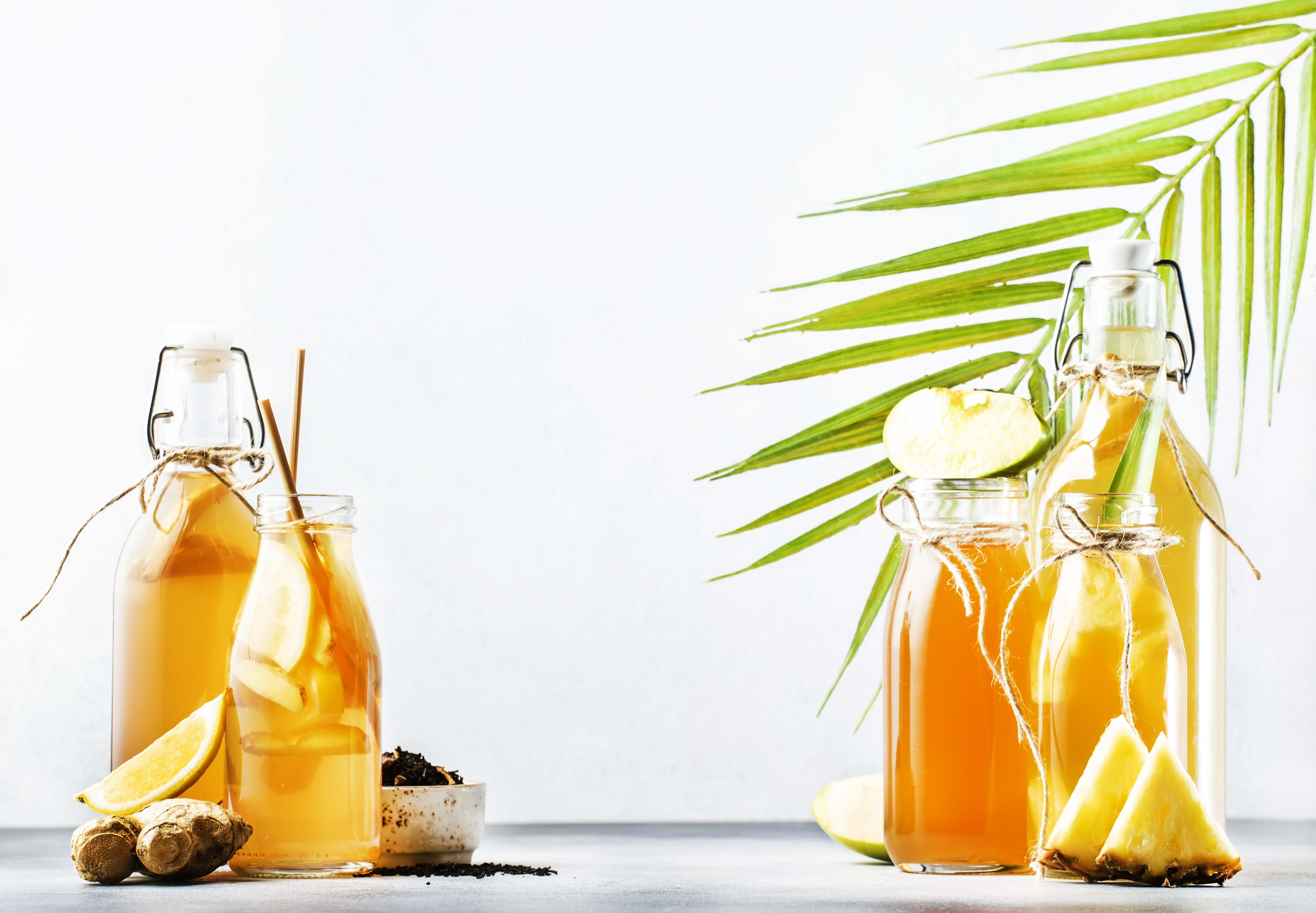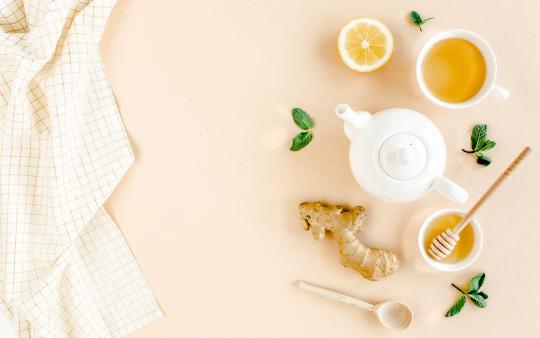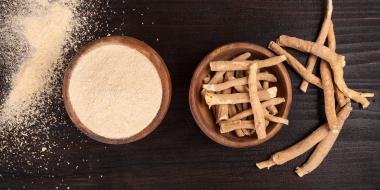Oftentimes when a patient calls me but isn’t able to immediately get to the office, I’ll prescribe medicine from the kitchen! One herb I find I call upon time and again, for a multitude of ailments, is ginger. Typically on hand in most people’s kitchens, a knob of gingerroot can be quickly whipped up into a healing cup of tea. Add a spoonful of sweet honey, and even children will clamor for a sip or two.
Ginger, also known as Zingiber officiale, is a member of the same family as heavy-hitters turmeric and cardamom, and has been used in Traditional Chinese Medicine and Ayurveda practices for thousands of years as both a flavour enhancer and medicinal herb.
Spread over the centuries via trade, ginger holds great auspiciousness in many cultures. In the East, when a child was born, a knob of ginger was placed at the entranceway of Chinese homes to absorb the harmful character traits of visitors, and historical research suggests that ginger was one of the first Eastern herbs that was utilized in the West! Ginger was popular in medieval Tudor England as a medicinal and culinary spice—in fact, it was during this time that gingerbread became the treat of choice! Widely available in everything from powders and crystallized versions to teas and candies, ginger is just about everywhere—and for good reason! More than just a warming spice that rounds out a number of dishes, ginger is an essential to any medicinal pantry!
Ginger
Zingiber officinale
Family: Zingiberacea
Common Name: Ginger, East Indian Pepper, Jamaica ginger
Parts Used: Roots and rhizomes, dried
Taste: Sweet, bitter, pungent, spicy, sharp
Energy: Warm, dry, sweet, pungent
Active constituents: Rich in volatile oil which includes zingiberene, bisabolene, zingiberole, zingiberenol, curcumene, phellandrene, borneol, methlheptenone, camphene, norneol, cineol, linalool, citral, cumene, pinene, cymene; aromatic ketones gingerols, shogoals, and zingerone; starch, mucilage, resin
Herbal Actions: Antispasmodic, stimulant (circulatory), carminative, rubefacient, diaphoretic (especially in children), diffusive
System tropism: Digestive: stomach, liver, intestines, heart, circulatory system
Medicinal actions: Anti-nausea, antiemetic, prokinetic, antioxidant, anti-inflammatory, antibacterial, hypolipidemic
Dosage
Tincture (1:5): 1.25–5 ml. 3x daily.
Tea: ½–1 tsp with 150 ml boiled water. Steep 10 minutes. 2–3x daily.
Fresh infusion: 2–3 cm fresh root per cup of water. Bring to boil, covered for 20 minutes. 2–3x daily.
Full System Support
While ginger has long been known for its anti-nauseant action, especially for those suffering from morning sickness or post-operative nausea, research has shown that it can do so much more!
Amazing anti-inflammatory
Ginger can help in a whole host of inflammation-based illnesses, including osteoarthritis. It is thought that its anti-inflammatory effects may be due to the inhibition of prostaglandin-mediated inflammation.
Digestive aid
Ginger can alleviate symptoms such as cramping, bloating, and nausea—all of which are common with digestive concerns. Further, some studies have indicated that 2 g of ginger daily for 28 days may help those at an in increased risk for colorectal cancer!
Indications: Motion sickness, nausea, seasickness, and vomiting (anti-nauseant); abdominal pain (warming carminative), adult colic (intestinal antispasmodic), fatigue (digestive strengthening), liver (liver stimulant), vitiligo (bowel strengthening) weight (digestive tonic), bowels (bowel regulator, warming digestive aid), dyspepsia (digestive aid, warming digestive stimulant, anti-nauseant)
Cardiovascular comfort
Studies have shown that ginger can help modulate cholesterol to healthy levels. It also inhibits inflammation and reduces blood glucose to help reverse insulin resistance.
Breathe easy
Ginger is a known diaphoretic, which means it brings about sweating and blood to your core. It has even shown promise in helping with tuberculosis!
Female friend
Not only can ginger help decrease inflammation associated with your monthly cycle, research has also demonstrated its ability to encourage menstruation, diminish dysmenorrhea, manage migraines and headaches, and alleviate pelvic congestion.
Indications: Menstrual cramps and suppressed menstruation (blood mover); morning sickness (anti-nauseant)
Circulatory care
Ginger helps to increase the circulation of blood to the digestive organs, stimulates peristalsis (intestinal movement), and increases the tone of the intestinal muscle.
Indications: Poor circulation (digestive warming), leg cramps (circulatory stimulant), chills (warming stimulant)
Contraindications & Safety
While ginger is generally considered safe for everyone, those with active gallstones, GERD, and/or peptic ulcer disease, should proceed with caution. Ginger may also increase the absorption of other medications, so it is important to speak with a healthcare provider before self-administering therapeutic doses.

Ginger Beer
*adapted from Sandor Katz, Wild Fermentation: The Flavor, Nutrition, and Craft of Live-Culture Foods.
Ferment on this
Like making your own kombucha or sourdough bread, you can keep the ginger beer party going by reserving a few tablespoons of the active starter, then replenishing it with water, grated ginger, and sugar, as directed in the instructions below. That way, you’ll always have a bubbly bevvie on hand!
This tasty “soft drink” depends on the fermentation process in order achieve effervescence. If you’ve never tried your hand at making your own starter, don’t be afraid! Simply combine the ingredients, set aside, and wait for the magic to happen! The result is bubbly, tasty, and totally kid friendly. And within a few days, you’ll have a gingery beverage the whole family is sure to love!
Make the starter
- 3” or more fresh ginger root
- 2 c sugar
- 2 lemons
- Water
Instructions - for the ferment
- In a large glass jar, combine 2 tsp grated ginger, skin and flesh, and 2 tsp sugar to 1 c of water. Stir well, cover opening with cheesecloth (or coffee filter) to allow air circulation and leave in a warm spot.
- Add 2 tsp of grated ginger and 2 tsp of sugar to the jar every day or so, stir, and re-cover, until the mixture begins to bubble (which can be anywhere from 2 days to 1 week).
- Once the bubbles form, you can make the ginger beer!
Instructions - for the ginger beer
- Boil 2 quarts of water. Add 2” of grated gingerroot (if you want an intense gingery flavour, add up to 6” of grated root) and 1½ c sugar. Let mixture boil for 15 minutes.
- Allow to cool.
- Once cooled, strain ginger out and add in the juice of two lemons. Add in enough water to make 4 L of ginger beer.
- Siphon the beer into sealable jars or bottles—ones that have rubber gasket bail-tops are ideal for this purpose.
- Let ginger beer continue to ferment by leaving the bottles in a warm spot for about two weeks. Refrigerate once it reaches a taste you like.
You may also enjoy: Sweet and Zingy Ginger Tea, Flavorful Immune System Boosters, and 6 Safe and Healthy Ways to Detoxify Your Body.






